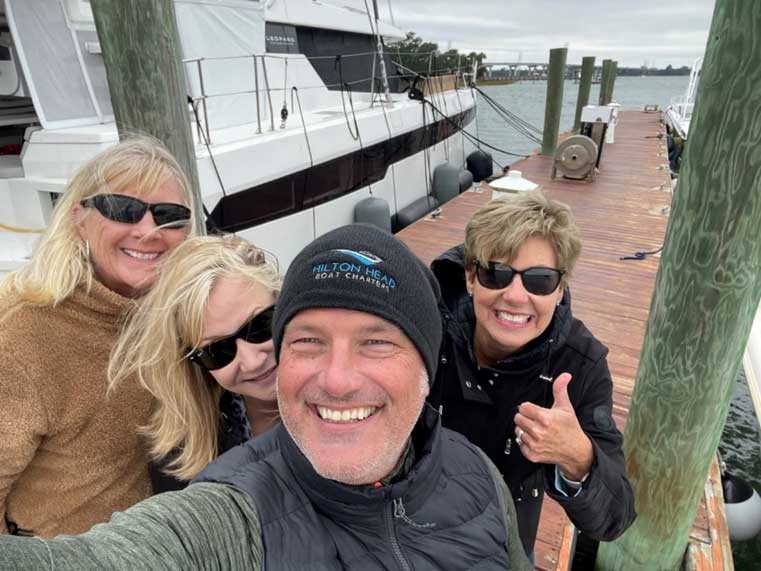Longtime resident Captain Neil has lived on Hilton Head Island for over 19 years. Neil is a partner and seasoned Master Captain with Hilton Head Boat Charters (www.hhiboatcharters.com) – a premium boat charter service that runs private dolphin tours, a popular Hilton Head Sunset Cruise, custom tours, and the occasional Hilton Head Bachelorette party😊

January 2023 – Captain Neil is getting the thumbs up from another satisfied group.
Hands down, one of the most popular things to do in Hilton Head is a Hilton Head Boat Tour. With our boat charter service, our two-hour Hilton Head Dolphin Tours are our most well-liked cruises. But why is that? First – Dolphins are plentiful in the waters of the low country.
There are only a few tours that we can remember that we have yet to encounter them. Second – Dolphins are majestic animals that are easily spotted in our waters as they frequently need to come up for air. Third – Dolphins are friendly (unlike sharks) and exhibit fun and unique behaviors that make each sighting completely different.
This article will take a deep dive into our local Atlantic Bottlenose Dolphin. Since we run about 5-10 dolphin tours a day, 365 days a year, we field many questions. Below – and in no particular order, you will find twenty-five of the most common questions we get from our guests.
- What type(s)of Dolphin do we have here on Hilton Head Island? On Hilton Head we have the Atlantic Bottlenose dolphin. There are over 60 different species of Dolphin worldwide, but we have only Atlantic Bottlenose Dolphin here.
- How many dolphins do you have in Hilton Head?It is estimated that over 150 dolphins are here year-round. In the summer months, that population tends to double in size.
- Why are they called “Bottlenose” dolphins?They are called “bottlenose” because of their short and stubby snouts.
- How big does Dolphin get?Adult bottlenose dolphins can reach 6 to 12 feet in length and weigh 400 to 800 pounds. Full-grown males are slightly larger than adult females.
- How long does a Dolphin generally live?40 to 60 years and sometimes beyond even that!
- How often do they come up for air?Because they are mammals, they come to the surface to breathe, usually about twice a minute.
- How does a Dolphin Sleep?Dolphins never stop swimming, and they have two lobes in their brain that act separately – one side sleeps while the other stays awake to breathe.
- Is there a good time or a place to find them?We see dolphins year-round in Hilton Head and locate them anywhere and everywhere – sounds, creeks, backwaters, rivers, bays, the ocean – etc.
- Can you feed or swim with the Dolphin?No, both are illegal.
- How many teeth does an Atlantic Bottlenose dolphin have?They have 86 to 100 sharp teeth, which they use to catch slippery fish.
- That’s a lot of teeth. That’s for them to chew their fish, right?Instead of using their teeth to chew, dolphins grip fish with their teeth, then swallow the fish whole—headfirst—so the spines of the fish don’t catch in their throats.
- What do Dolphins feed on?– Dolphins eat – fish, squid, crab, and shrimp.
- How do Dolphins feed?They exhibit a range of feeding strategies, including:
- Strand Feeding – which is cooperative hunting (working together to herd fish into tight circles).
- Following fishing boats.
- Digging in the sand to uncover food.
- Chasing fish onto mud banks
- How fast do they swim?They can reach up to 18 mph speeds and dive over 250 meters below the surface.
- Do Dolphins vary in color?Yes – Dolphins living close to shore or in shore are often smaller and lighter in color than those residing offshore.
- Do sharks attack Atlantic Bottlenose dolphins?A 2006 study found almost 75 percent of bottlenose dolphins surveyed were scarred by shark bites.
- Can a dolphin kill a shark?A single dolphin is not likely. But in pods – absolutely. Dolphin snouts are built like battering rams, and that’s precisely how they use them. Dolphins will ram sharks at high speed, using their sturdy bills to cause massive internal injuries. They specifically target the shark’s underbelly and gills, where they can do the most damage.
- What is strand feeding?Strand feeding is a unique behavior that bottlenose dolphins near Hilton Head and Charleston, SC, herd and catch fish on the shoreline. Its name comes from the short beaching (or stranding) as the dolphins push their prey ashore before they slide back into the water.
- Aren’t Dolphins endangered?Dolphins in the United States are not endangered.
- How big are dolphin pods?They generally range between 10 and 15 dolphins.
- How long can Dolphins hold their breath?Approximately up to 7 minutes.
- When is the mating season?It can happen all year long. But birthing season generally occurs in late spring / early summer.
- How do you tell the difference between a shark and Dolphin?
- Sharks are fish, while dolphins are mammals.
- Sharks are cold-blooded, while dolphins are warm-blooded.
- Dolphins breathe through their lungs, while sharks breathe through their gills.
- Sharks have several rows of teeth, while Dolphin has a single row of teeth.
- Sharks are solitary hunters, while dolphins generally work in pods.
- Sharks have rough skin, while dolphins have smooth skin.
- Sharks are less intelligent, while dolphins are pretty intelligent.
- Sharks have vertical tail fin while Dolphin has a horizontal tail fluke.
- Dolphins can survive in the river, while sharks cannot survive in water with less salt.
- How often do they reproduce?A female dolphin can potentially bear a calf every two years, but calving intervals generally average three years. Females are pregnant for about 12 months.
- How long do calves stay with their mothers?Once calves are born, they nurse for 20 months and remain with their mothers for 3 to 6 years.


